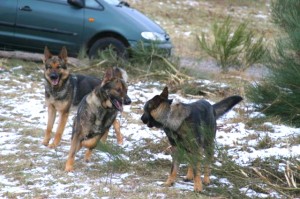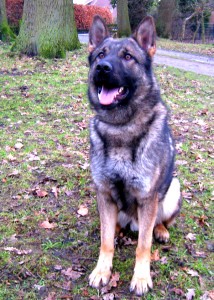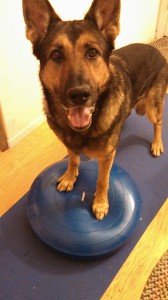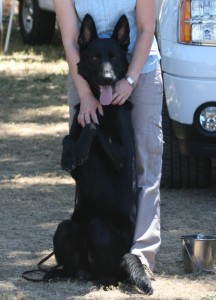Core Conditioning for Your German Shepherd Dog
 Whether it is taking a long walk or going skijoring with your dog, outdoor conditioning opportunities abound once the rain or snow stops falling or the sun starts shining. But what about those days when both you and your canine can’t quite brave the winter weather? Try some core conditioning exercises at home instead! These are simple, fun, easy to do, and can require little space to perform.
Whether it is taking a long walk or going skijoring with your dog, outdoor conditioning opportunities abound once the rain or snow stops falling or the sun starts shining. But what about those days when both you and your canine can’t quite brave the winter weather? Try some core conditioning exercises at home instead! These are simple, fun, easy to do, and can require little space to perform.
Canine Core and Balance Conditioning
Core strength training is often neglected by pet owners and competition dog owners alike. Typically, the focus is on skill training or on making sure the dog receives enough exercise, but little thought is given to helping strengthen the dog’s midsection, spine, rear end, and overall balance and body awareness. Improving these aspects can lead to improvements in balance, flexibility, strength, and agility. This is especially important for canine athletes and for senior dogs, who begin to gradually lose muscle tone, balance, and flexibility as they age.
Below is a list of several excellent exercises that can be performed indoors. However, there are a few safety considerations to discuss first!
Exercise Safety for your Trained German Shepherd Protection Dog
- Always make sure the dog is on a non-slip surface when performing core exercises. Carpet generally works well, but if you have tile or wood floors, placing a yoga mat or two on these can provide a nice surface for performing these exercises.
- Always contact your veterinarian first if your dog has had any sort of previous injury or condition that could be aggravated by these exercises.
- Use caution when working with young growing dogs, dogs with long backs prone to injury, dogs with pre-existing back conditions, or dogs recovering from surgery or injury.
Exercises
1. Canine Squats
 This is a simple exercise that helps build muscle tone and strength in the rear end of dogs. Each doggie squat consists of a sit to a stand. The key here is for the dog to sink into a stationery sit, and then to push up to a stand without moving their rear feet out to a new position. You can build up to several sets of five repetitions each (three to five sets of five doggie squats each). This video below does an excellent job of demonstrating both basic dog squats and more advanced squats using various exercise equipment:
This is a simple exercise that helps build muscle tone and strength in the rear end of dogs. Each doggie squat consists of a sit to a stand. The key here is for the dog to sink into a stationery sit, and then to push up to a stand without moving their rear feet out to a new position. You can build up to several sets of five repetitions each (three to five sets of five doggie squats each). This video below does an excellent job of demonstrating both basic dog squats and more advanced squats using various exercise equipment:
2. Cavaletti – Pole Work
Cavaletti work can help the dog develop core strength, body awareness, balance, and flexibility. This can be useful for helping a dog recover after surgery or injury, or even to just encourage even muscle development on both sides of the body. PVC pieces, wooden dowels, or even broom handles work well for this exercise. Start out by placing four or five poles on the floor in a hallway, where the dog cannot walk around them. Space out the poles so that the dog can walk over them easily, with one or two strides between poles. The dog will have to lift each foot individually over the poles, isolating the muscles in each limb and encouraging even muscle use on both sides of the body. These poles can later be lifted off the floor using small cardboard boxes, stacks of books, mesh baskets, or road cones. Increasing the height will increase the difficulty, as will varying the spacing. When the dog gains more experience, you can space the cavaletti so that the dog can trot over them, which now allows the limbs to work in pairs, rather than singularly. The video below helps demonstrate and explain cavaletti use:
 3. Balance Exercises
3. Balance Exercises
These exercises ask the dog to perform a familiar motion like a stand on a slightly uneven surface, such as a couch cushion, a rocker board, an exercise disc, etc. The “unstable” surface requires the dog to tighten their core muscles, shift their weight ever so slightly, and work their whole body to stay balanced. Simply standing with the front end on the elevated and wobbly surface will engage the core muscles, shoulder muscles, and all the muscles in the dog’s rear end. We are not endorsing any particular company or their products, but the video linked below shows a wide variety of different balance exercises using different pieces of equipment, providing a good overview of the various exercises available to develop balance and coordination. You don’t need to go out and buy a huge amount of equipment, however. Using objects like a pillow, cushion, or even a box is enough to get you both started!
4. Pivots
This is an excellent exercise to teach rear end awareness. It can also be especially useful for dogs that are accustomed to only working in one direction. For example, dogs that do competitive obedience or IPO are accustomed to heeling and pivoting on the left of the handler. Most pivots in these sports require the dog to tuck his rear end in to the right, so that he does not swing out wide. This is especially common in IPO obedience, as many handlers use tight left turns to teach their dog to stay back and tuck his rear end back into position. Teaching a dog to pivot in the opposite direction can be useful for creating better balance and more even muscle tone in the rear. The pivot exercise can also be used to teach the dog to find a straight front position no matter where the handler is, and to teach the dog to find proper heel position from nearly any angle. The video linked below breaks the pivot exercise down into easy-to-teach steps (please note: this is not an endorsement for any particular trainer; the video is just for informational purposes.):
 5. Sit Pretty
5. Sit Pretty
It’s more than just a trick! Teaching a dog to sit up straight and balance on his haunches is an excellent core strengthening exercise, particularly for dogs that have longer backs like our German Shepherd Dogs. Sitting up/Sitting pretty is actually a complex exercise that requires balance, coordination, and strength to perform for any length of time. Therefore, it is important to build this exercise slowly, so as to allow the dog’s core muscles time to strengthen and adapt. The video linked below provides a very thoughtful and thorough description of how to properly teach a dog to sit up or sit pretty, and includes valuable information on how to avoid injury in teaching this exercise (note: video is for information purposes only):
Teaching The Dog to Sit Up (link opens in new window)
Remember to always consult your veterinarian before creating a conditioning or recovery program for a dog with a prior or current injury. Next blog, we will discuss several different games you can play to entertain, teach, and even condition your dog indoors!

